HRMT19021: Principles of Employment Relations in Australia Essay
VerifiedAdded on 2023/01/19
|13
|3716
|34
Essay
AI Summary
This essay examines the main employment characteristics of the Australian labour market, including legislation, arbitration, protectionism, collective bargaining, and the role of unions. It then reviews the significant changes that have occurred since 1970, such as shifts in employment levels, the rise of part-time and casual work, and the increasing participation of women in the workforce. The essay also explores the evolution of trade unions, from their growth to their decline in membership. Furthermore, it analyzes the impact of these changes on employment relations, considering government policies, wage determination, and the evolving dynamics between employers, employees, and unions. The analysis covers various factors, including the impact of government policies, wage determination, and the evolving relationship between employers, employees, and unions. The essay concludes with a discussion on the implications of these changes for the future of employment relations in Australia.
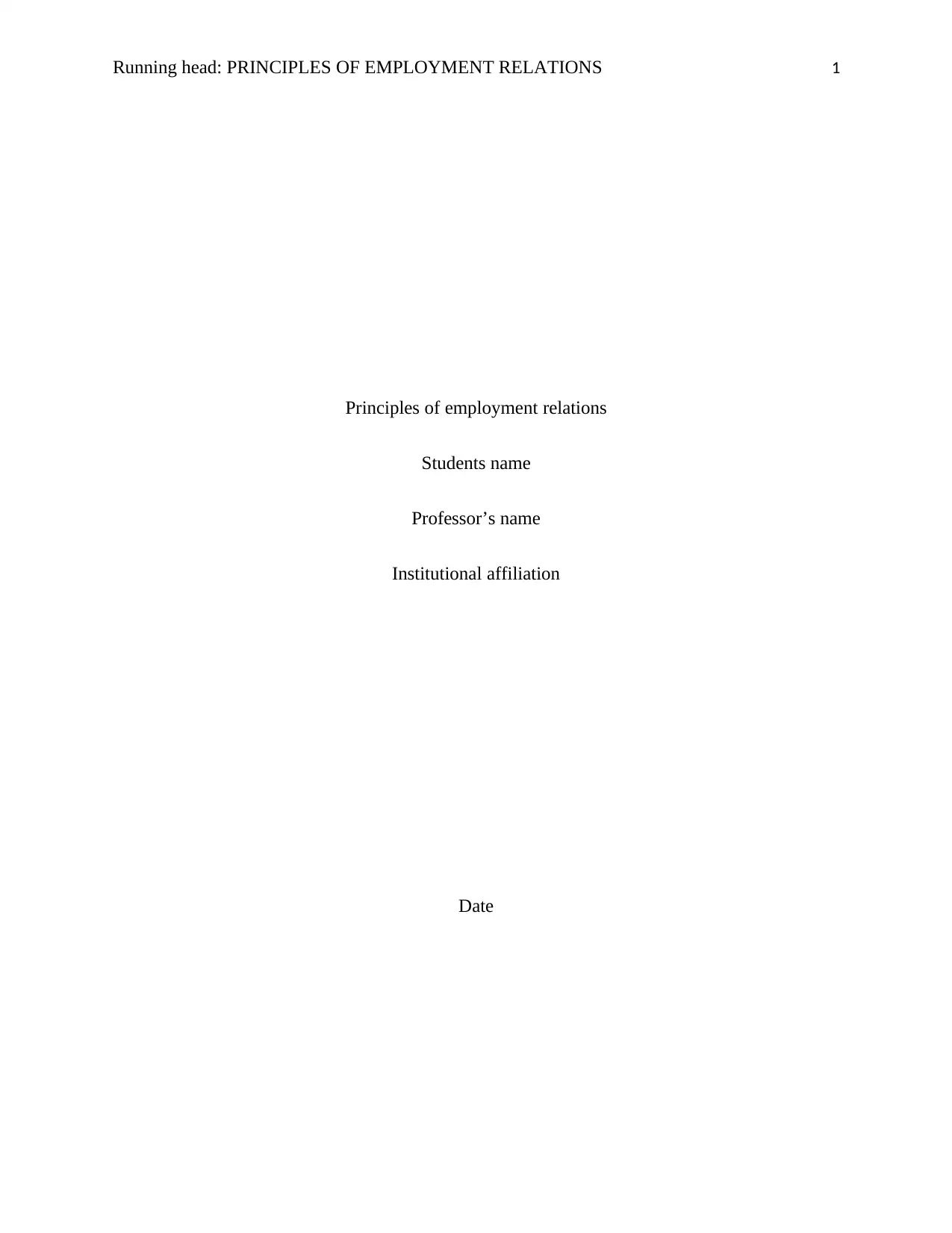
Running head: PRINCIPLES OF EMPLOYMENT RELATIONS 1
Principles of employment relations
Students name
Professor’s name
Institutional affiliation
Date
Principles of employment relations
Students name
Professor’s name
Institutional affiliation
Date
Paraphrase This Document
Need a fresh take? Get an instant paraphrase of this document with our AI Paraphraser
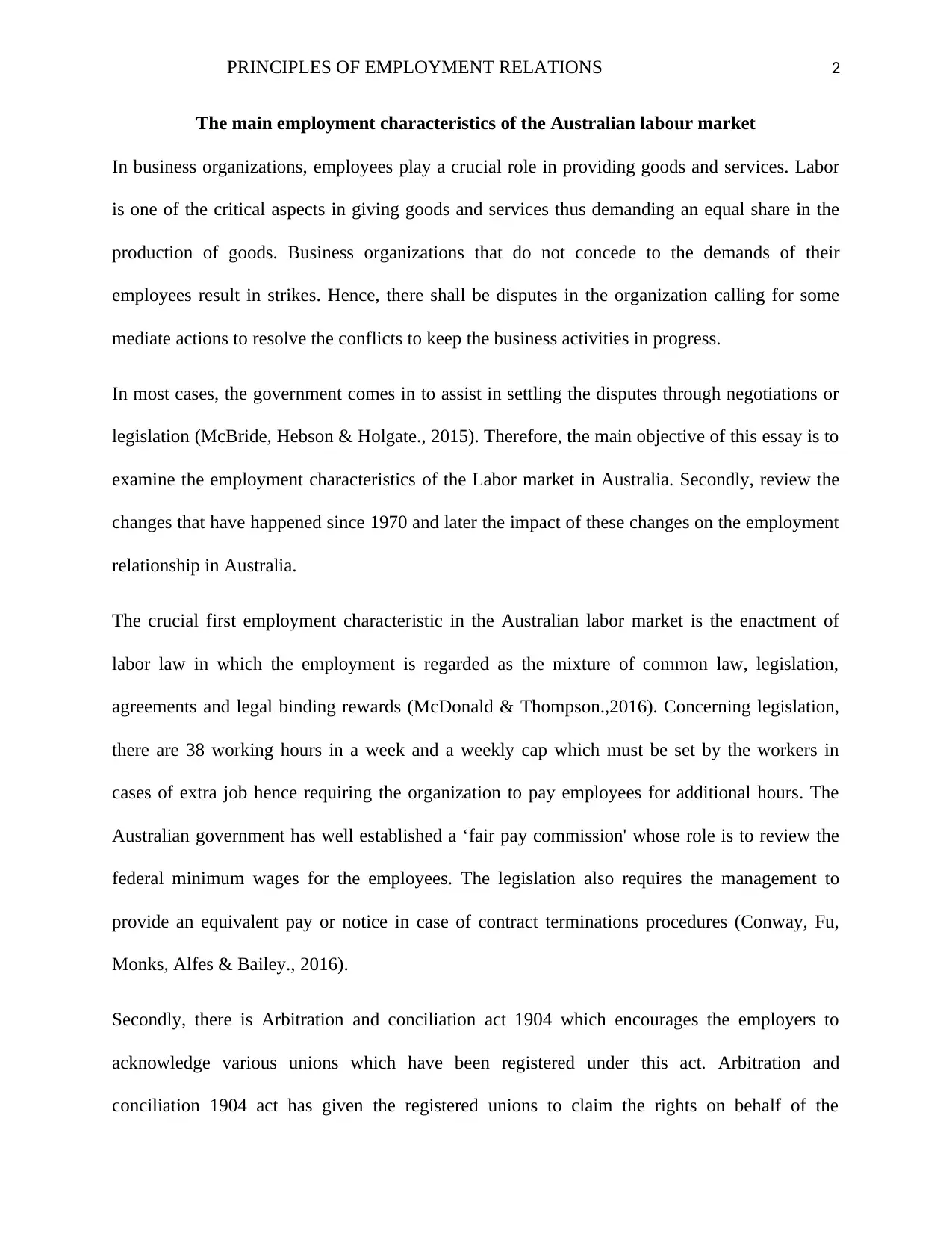
PRINCIPLES OF EMPLOYMENT RELATIONS 2
The main employment characteristics of the Australian labour market
In business organizations, employees play a crucial role in providing goods and services. Labor
is one of the critical aspects in giving goods and services thus demanding an equal share in the
production of goods. Business organizations that do not concede to the demands of their
employees result in strikes. Hence, there shall be disputes in the organization calling for some
mediate actions to resolve the conflicts to keep the business activities in progress.
In most cases, the government comes in to assist in settling the disputes through negotiations or
legislation (McBride, Hebson & Holgate., 2015). Therefore, the main objective of this essay is to
examine the employment characteristics of the Labor market in Australia. Secondly, review the
changes that have happened since 1970 and later the impact of these changes on the employment
relationship in Australia.
The crucial first employment characteristic in the Australian labor market is the enactment of
labor law in which the employment is regarded as the mixture of common law, legislation,
agreements and legal binding rewards (McDonald & Thompson.,2016). Concerning legislation,
there are 38 working hours in a week and a weekly cap which must be set by the workers in
cases of extra job hence requiring the organization to pay employees for additional hours. The
Australian government has well established a ‘fair pay commission' whose role is to review the
federal minimum wages for the employees. The legislation also requires the management to
provide an equivalent pay or notice in case of contract terminations procedures (Conway, Fu,
Monks, Alfes & Bailey., 2016).
Secondly, there is Arbitration and conciliation act 1904 which encourages the employers to
acknowledge various unions which have been registered under this act. Arbitration and
conciliation 1904 act has given the registered unions to claim the rights on behalf of the
The main employment characteristics of the Australian labour market
In business organizations, employees play a crucial role in providing goods and services. Labor
is one of the critical aspects in giving goods and services thus demanding an equal share in the
production of goods. Business organizations that do not concede to the demands of their
employees result in strikes. Hence, there shall be disputes in the organization calling for some
mediate actions to resolve the conflicts to keep the business activities in progress.
In most cases, the government comes in to assist in settling the disputes through negotiations or
legislation (McBride, Hebson & Holgate., 2015). Therefore, the main objective of this essay is to
examine the employment characteristics of the Labor market in Australia. Secondly, review the
changes that have happened since 1970 and later the impact of these changes on the employment
relationship in Australia.
The crucial first employment characteristic in the Australian labor market is the enactment of
labor law in which the employment is regarded as the mixture of common law, legislation,
agreements and legal binding rewards (McDonald & Thompson.,2016). Concerning legislation,
there are 38 working hours in a week and a weekly cap which must be set by the workers in
cases of extra job hence requiring the organization to pay employees for additional hours. The
Australian government has well established a ‘fair pay commission' whose role is to review the
federal minimum wages for the employees. The legislation also requires the management to
provide an equivalent pay or notice in case of contract terminations procedures (Conway, Fu,
Monks, Alfes & Bailey., 2016).
Secondly, there is Arbitration and conciliation act 1904 which encourages the employers to
acknowledge various unions which have been registered under this act. Arbitration and
conciliation 1904 act has given the registered unions to claim the rights on behalf of the
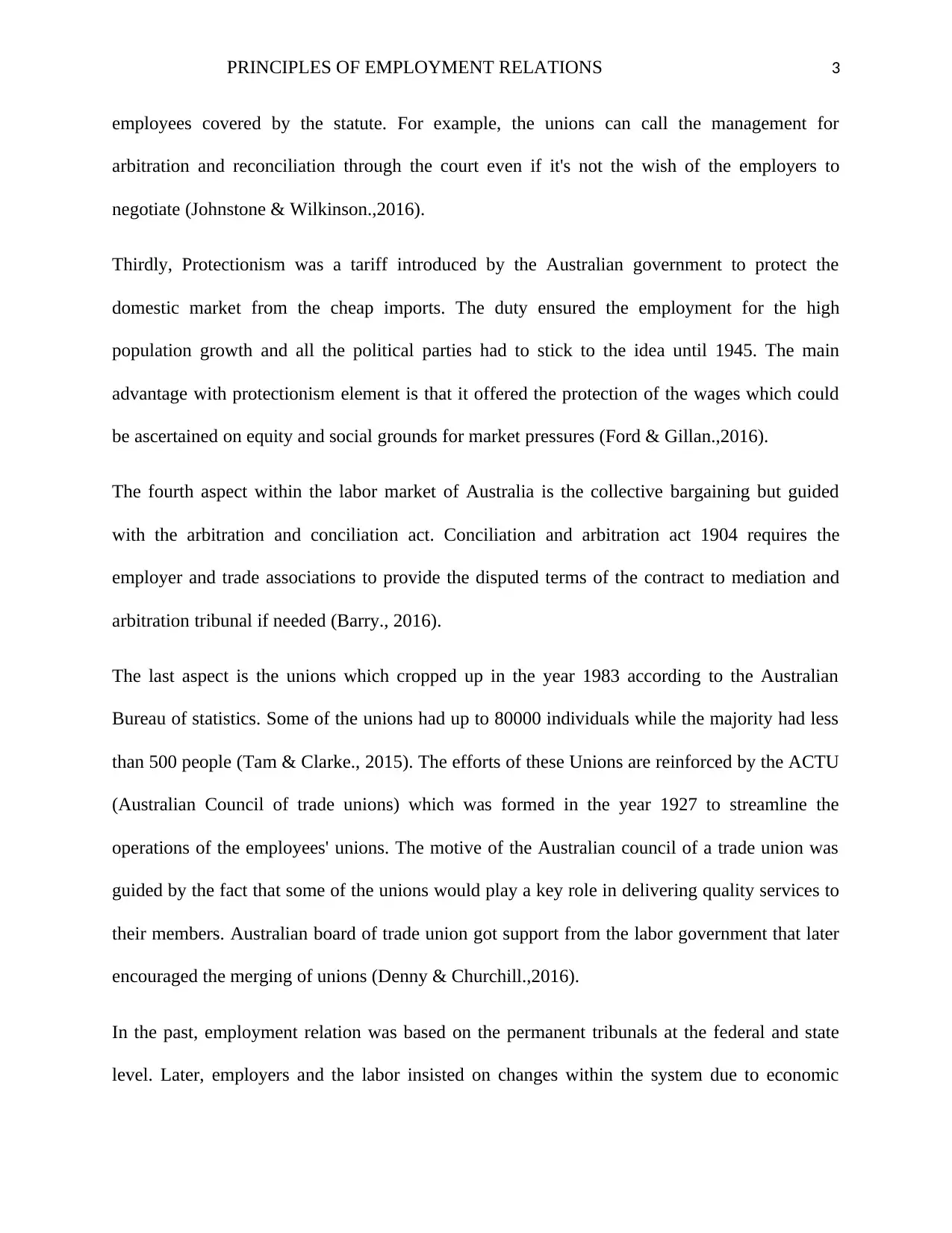
PRINCIPLES OF EMPLOYMENT RELATIONS 3
employees covered by the statute. For example, the unions can call the management for
arbitration and reconciliation through the court even if it's not the wish of the employers to
negotiate (Johnstone & Wilkinson.,2016).
Thirdly, Protectionism was a tariff introduced by the Australian government to protect the
domestic market from the cheap imports. The duty ensured the employment for the high
population growth and all the political parties had to stick to the idea until 1945. The main
advantage with protectionism element is that it offered the protection of the wages which could
be ascertained on equity and social grounds for market pressures (Ford & Gillan.,2016).
The fourth aspect within the labor market of Australia is the collective bargaining but guided
with the arbitration and conciliation act. Conciliation and arbitration act 1904 requires the
employer and trade associations to provide the disputed terms of the contract to mediation and
arbitration tribunal if needed (Barry., 2016).
The last aspect is the unions which cropped up in the year 1983 according to the Australian
Bureau of statistics. Some of the unions had up to 80000 individuals while the majority had less
than 500 people (Tam & Clarke., 2015). The efforts of these Unions are reinforced by the ACTU
(Australian Council of trade unions) which was formed in the year 1927 to streamline the
operations of the employees' unions. The motive of the Australian council of a trade union was
guided by the fact that some of the unions would play a key role in delivering quality services to
their members. Australian board of trade union got support from the labor government that later
encouraged the merging of unions (Denny & Churchill.,2016).
In the past, employment relation was based on the permanent tribunals at the federal and state
level. Later, employers and the labor insisted on changes within the system due to economic
employees covered by the statute. For example, the unions can call the management for
arbitration and reconciliation through the court even if it's not the wish of the employers to
negotiate (Johnstone & Wilkinson.,2016).
Thirdly, Protectionism was a tariff introduced by the Australian government to protect the
domestic market from the cheap imports. The duty ensured the employment for the high
population growth and all the political parties had to stick to the idea until 1945. The main
advantage with protectionism element is that it offered the protection of the wages which could
be ascertained on equity and social grounds for market pressures (Ford & Gillan.,2016).
The fourth aspect within the labor market of Australia is the collective bargaining but guided
with the arbitration and conciliation act. Conciliation and arbitration act 1904 requires the
employer and trade associations to provide the disputed terms of the contract to mediation and
arbitration tribunal if needed (Barry., 2016).
The last aspect is the unions which cropped up in the year 1983 according to the Australian
Bureau of statistics. Some of the unions had up to 80000 individuals while the majority had less
than 500 people (Tam & Clarke., 2015). The efforts of these Unions are reinforced by the ACTU
(Australian Council of trade unions) which was formed in the year 1927 to streamline the
operations of the employees' unions. The motive of the Australian council of a trade union was
guided by the fact that some of the unions would play a key role in delivering quality services to
their members. Australian board of trade union got support from the labor government that later
encouraged the merging of unions (Denny & Churchill.,2016).
In the past, employment relation was based on the permanent tribunals at the federal and state
level. Later, employers and the labor insisted on changes within the system due to economic
⊘ This is a preview!⊘
Do you want full access?
Subscribe today to unlock all pages.

Trusted by 1+ million students worldwide
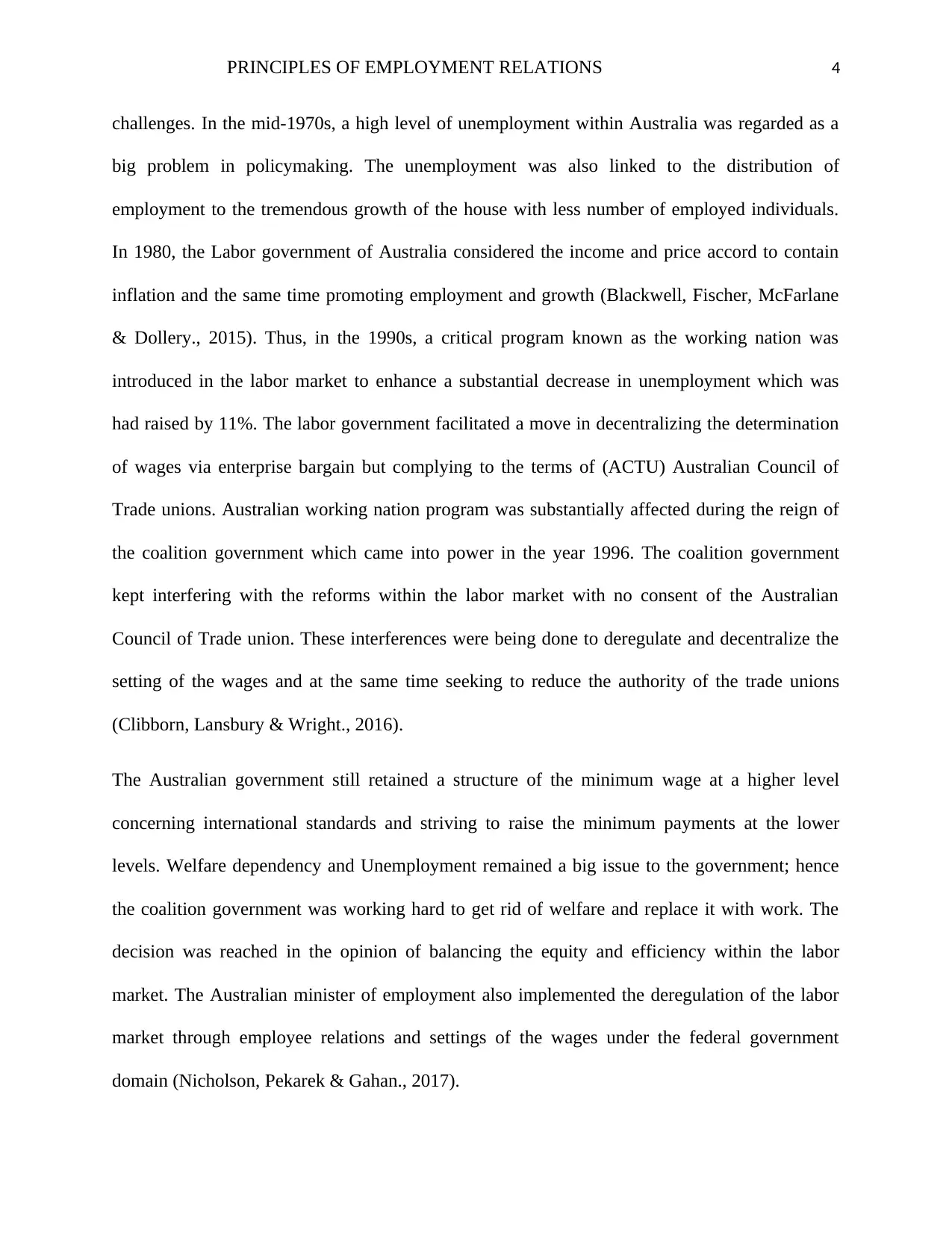
PRINCIPLES OF EMPLOYMENT RELATIONS 4
challenges. In the mid-1970s, a high level of unemployment within Australia was regarded as a
big problem in policymaking. The unemployment was also linked to the distribution of
employment to the tremendous growth of the house with less number of employed individuals.
In 1980, the Labor government of Australia considered the income and price accord to contain
inflation and the same time promoting employment and growth (Blackwell, Fischer, McFarlane
& Dollery., 2015). Thus, in the 1990s, a critical program known as the working nation was
introduced in the labor market to enhance a substantial decrease in unemployment which was
had raised by 11%. The labor government facilitated a move in decentralizing the determination
of wages via enterprise bargain but complying to the terms of (ACTU) Australian Council of
Trade unions. Australian working nation program was substantially affected during the reign of
the coalition government which came into power in the year 1996. The coalition government
kept interfering with the reforms within the labor market with no consent of the Australian
Council of Trade union. These interferences were being done to deregulate and decentralize the
setting of the wages and at the same time seeking to reduce the authority of the trade unions
(Clibborn, Lansbury & Wright., 2016).
The Australian government still retained a structure of the minimum wage at a higher level
concerning international standards and striving to raise the minimum payments at the lower
levels. Welfare dependency and Unemployment remained a big issue to the government; hence
the coalition government was working hard to get rid of welfare and replace it with work. The
decision was reached in the opinion of balancing the equity and efficiency within the labor
market. The Australian minister of employment also implemented the deregulation of the labor
market through employee relations and settings of the wages under the federal government
domain (Nicholson, Pekarek & Gahan., 2017).
challenges. In the mid-1970s, a high level of unemployment within Australia was regarded as a
big problem in policymaking. The unemployment was also linked to the distribution of
employment to the tremendous growth of the house with less number of employed individuals.
In 1980, the Labor government of Australia considered the income and price accord to contain
inflation and the same time promoting employment and growth (Blackwell, Fischer, McFarlane
& Dollery., 2015). Thus, in the 1990s, a critical program known as the working nation was
introduced in the labor market to enhance a substantial decrease in unemployment which was
had raised by 11%. The labor government facilitated a move in decentralizing the determination
of wages via enterprise bargain but complying to the terms of (ACTU) Australian Council of
Trade unions. Australian working nation program was substantially affected during the reign of
the coalition government which came into power in the year 1996. The coalition government
kept interfering with the reforms within the labor market with no consent of the Australian
Council of Trade union. These interferences were being done to deregulate and decentralize the
setting of the wages and at the same time seeking to reduce the authority of the trade unions
(Clibborn, Lansbury & Wright., 2016).
The Australian government still retained a structure of the minimum wage at a higher level
concerning international standards and striving to raise the minimum payments at the lower
levels. Welfare dependency and Unemployment remained a big issue to the government; hence
the coalition government was working hard to get rid of welfare and replace it with work. The
decision was reached in the opinion of balancing the equity and efficiency within the labor
market. The Australian minister of employment also implemented the deregulation of the labor
market through employee relations and settings of the wages under the federal government
domain (Nicholson, Pekarek & Gahan., 2017).
Paraphrase This Document
Need a fresh take? Get an instant paraphrase of this document with our AI Paraphraser
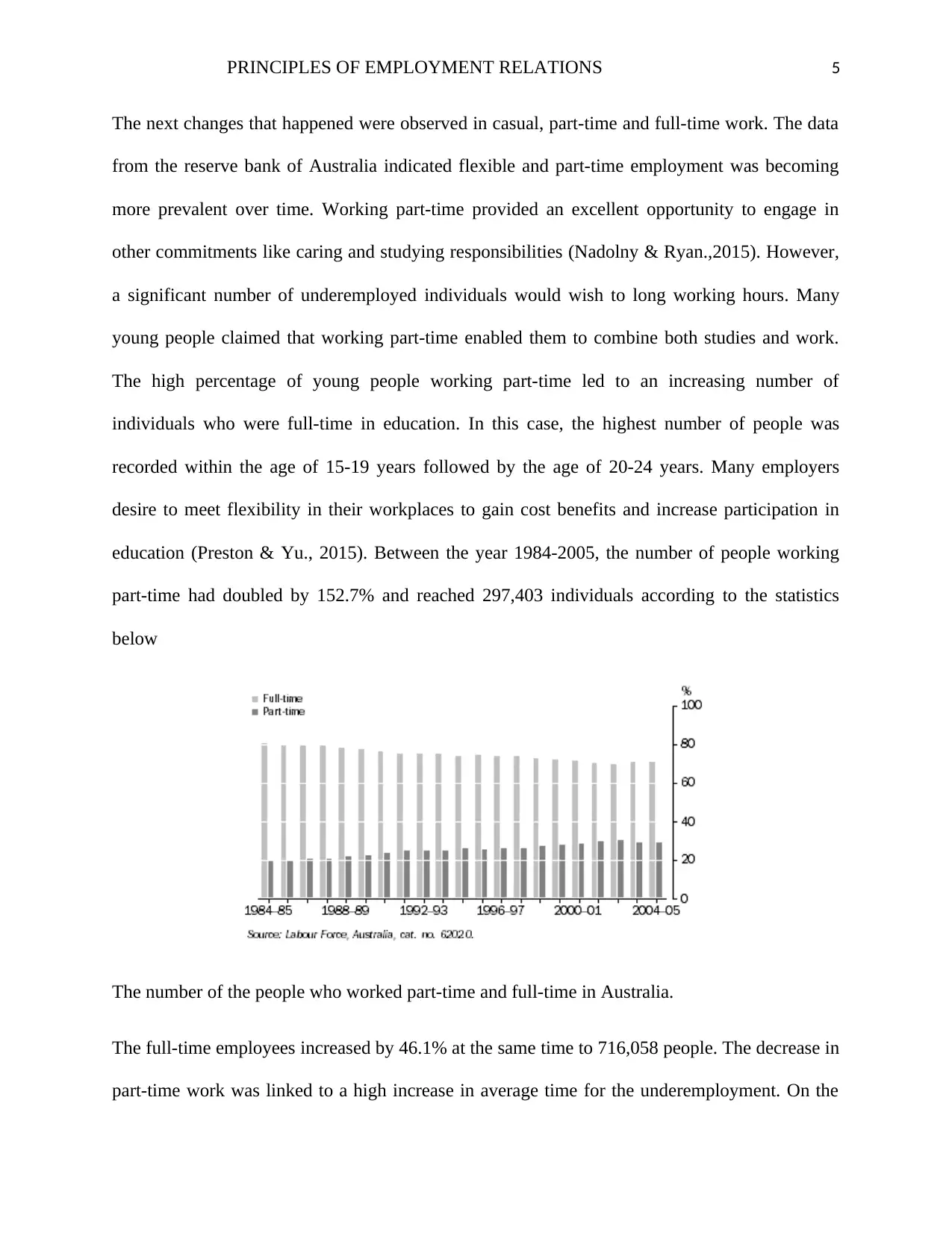
PRINCIPLES OF EMPLOYMENT RELATIONS 5
The next changes that happened were observed in casual, part-time and full-time work. The data
from the reserve bank of Australia indicated flexible and part-time employment was becoming
more prevalent over time. Working part-time provided an excellent opportunity to engage in
other commitments like caring and studying responsibilities (Nadolny & Ryan.,2015). However,
a significant number of underemployed individuals would wish to long working hours. Many
young people claimed that working part-time enabled them to combine both studies and work.
The high percentage of young people working part-time led to an increasing number of
individuals who were full-time in education. In this case, the highest number of people was
recorded within the age of 15-19 years followed by the age of 20-24 years. Many employers
desire to meet flexibility in their workplaces to gain cost benefits and increase participation in
education (Preston & Yu., 2015). Between the year 1984-2005, the number of people working
part-time had doubled by 152.7% and reached 297,403 individuals according to the statistics
below
The number of the people who worked part-time and full-time in Australia.
The full-time employees increased by 46.1% at the same time to 716,058 people. The decrease in
part-time work was linked to a high increase in average time for the underemployment. On the
The next changes that happened were observed in casual, part-time and full-time work. The data
from the reserve bank of Australia indicated flexible and part-time employment was becoming
more prevalent over time. Working part-time provided an excellent opportunity to engage in
other commitments like caring and studying responsibilities (Nadolny & Ryan.,2015). However,
a significant number of underemployed individuals would wish to long working hours. Many
young people claimed that working part-time enabled them to combine both studies and work.
The high percentage of young people working part-time led to an increasing number of
individuals who were full-time in education. In this case, the highest number of people was
recorded within the age of 15-19 years followed by the age of 20-24 years. Many employers
desire to meet flexibility in their workplaces to gain cost benefits and increase participation in
education (Preston & Yu., 2015). Between the year 1984-2005, the number of people working
part-time had doubled by 152.7% and reached 297,403 individuals according to the statistics
below
The number of the people who worked part-time and full-time in Australia.
The full-time employees increased by 46.1% at the same time to 716,058 people. The decrease in
part-time work was linked to a high increase in average time for the underemployment. On the
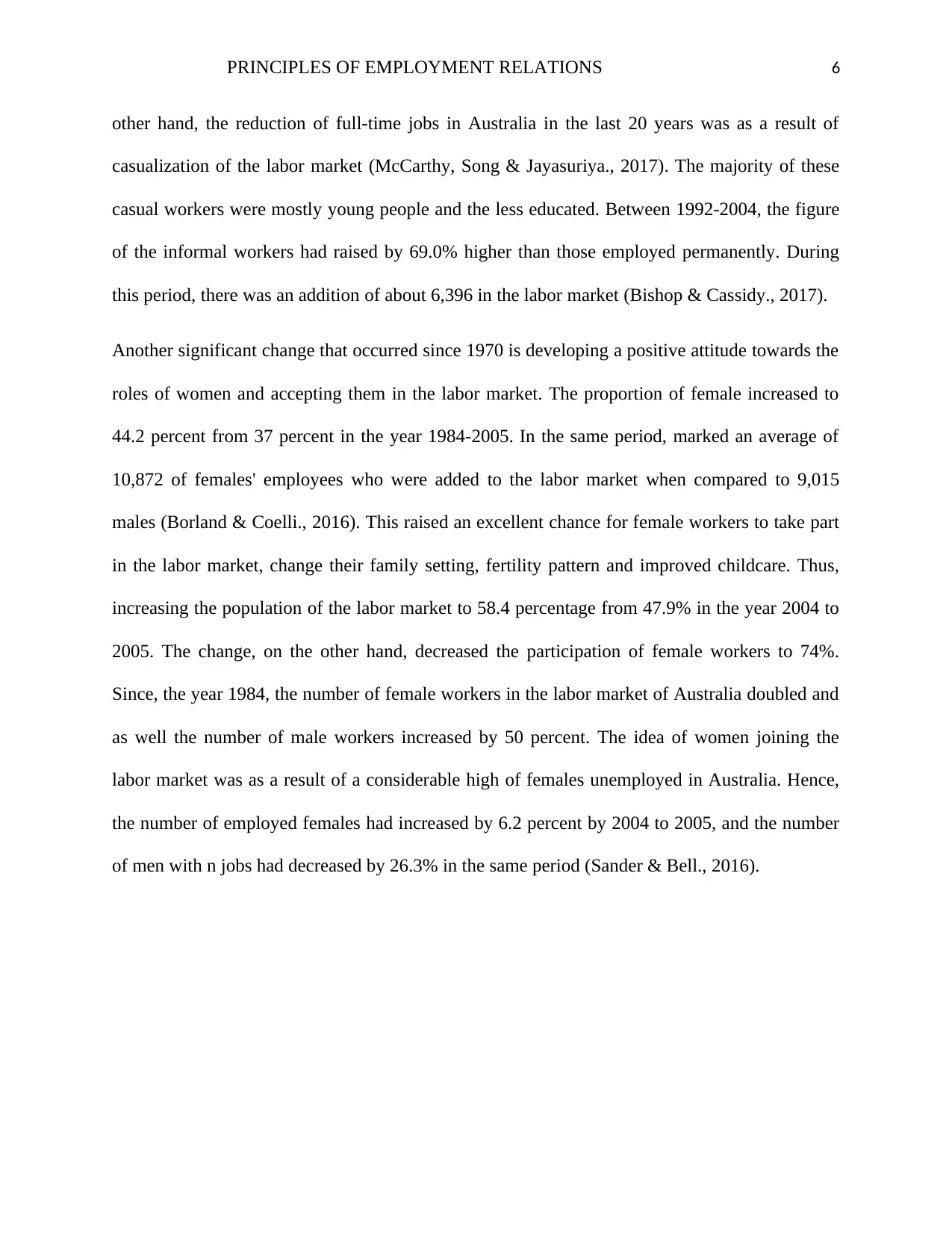
PRINCIPLES OF EMPLOYMENT RELATIONS 6
other hand, the reduction of full-time jobs in Australia in the last 20 years was as a result of
casualization of the labor market (McCarthy, Song & Jayasuriya., 2017). The majority of these
casual workers were mostly young people and the less educated. Between 1992-2004, the figure
of the informal workers had raised by 69.0% higher than those employed permanently. During
this period, there was an addition of about 6,396 in the labor market (Bishop & Cassidy., 2017).
Another significant change that occurred since 1970 is developing a positive attitude towards the
roles of women and accepting them in the labor market. The proportion of female increased to
44.2 percent from 37 percent in the year 1984-2005. In the same period, marked an average of
10,872 of females' employees who were added to the labor market when compared to 9,015
males (Borland & Coelli., 2016). This raised an excellent chance for female workers to take part
in the labor market, change their family setting, fertility pattern and improved childcare. Thus,
increasing the population of the labor market to 58.4 percentage from 47.9% in the year 2004 to
2005. The change, on the other hand, decreased the participation of female workers to 74%.
Since, the year 1984, the number of female workers in the labor market of Australia doubled and
as well the number of male workers increased by 50 percent. The idea of women joining the
labor market was as a result of a considerable high of females unemployed in Australia. Hence,
the number of employed females had increased by 6.2 percent by 2004 to 2005, and the number
of men with n jobs had decreased by 26.3% in the same period (Sander & Bell., 2016).
other hand, the reduction of full-time jobs in Australia in the last 20 years was as a result of
casualization of the labor market (McCarthy, Song & Jayasuriya., 2017). The majority of these
casual workers were mostly young people and the less educated. Between 1992-2004, the figure
of the informal workers had raised by 69.0% higher than those employed permanently. During
this period, there was an addition of about 6,396 in the labor market (Bishop & Cassidy., 2017).
Another significant change that occurred since 1970 is developing a positive attitude towards the
roles of women and accepting them in the labor market. The proportion of female increased to
44.2 percent from 37 percent in the year 1984-2005. In the same period, marked an average of
10,872 of females' employees who were added to the labor market when compared to 9,015
males (Borland & Coelli., 2016). This raised an excellent chance for female workers to take part
in the labor market, change their family setting, fertility pattern and improved childcare. Thus,
increasing the population of the labor market to 58.4 percentage from 47.9% in the year 2004 to
2005. The change, on the other hand, decreased the participation of female workers to 74%.
Since, the year 1984, the number of female workers in the labor market of Australia doubled and
as well the number of male workers increased by 50 percent. The idea of women joining the
labor market was as a result of a considerable high of females unemployed in Australia. Hence,
the number of employed females had increased by 6.2 percent by 2004 to 2005, and the number
of men with n jobs had decreased by 26.3% in the same period (Sander & Bell., 2016).
⊘ This is a preview!⊘
Do you want full access?
Subscribe today to unlock all pages.

Trusted by 1+ million students worldwide
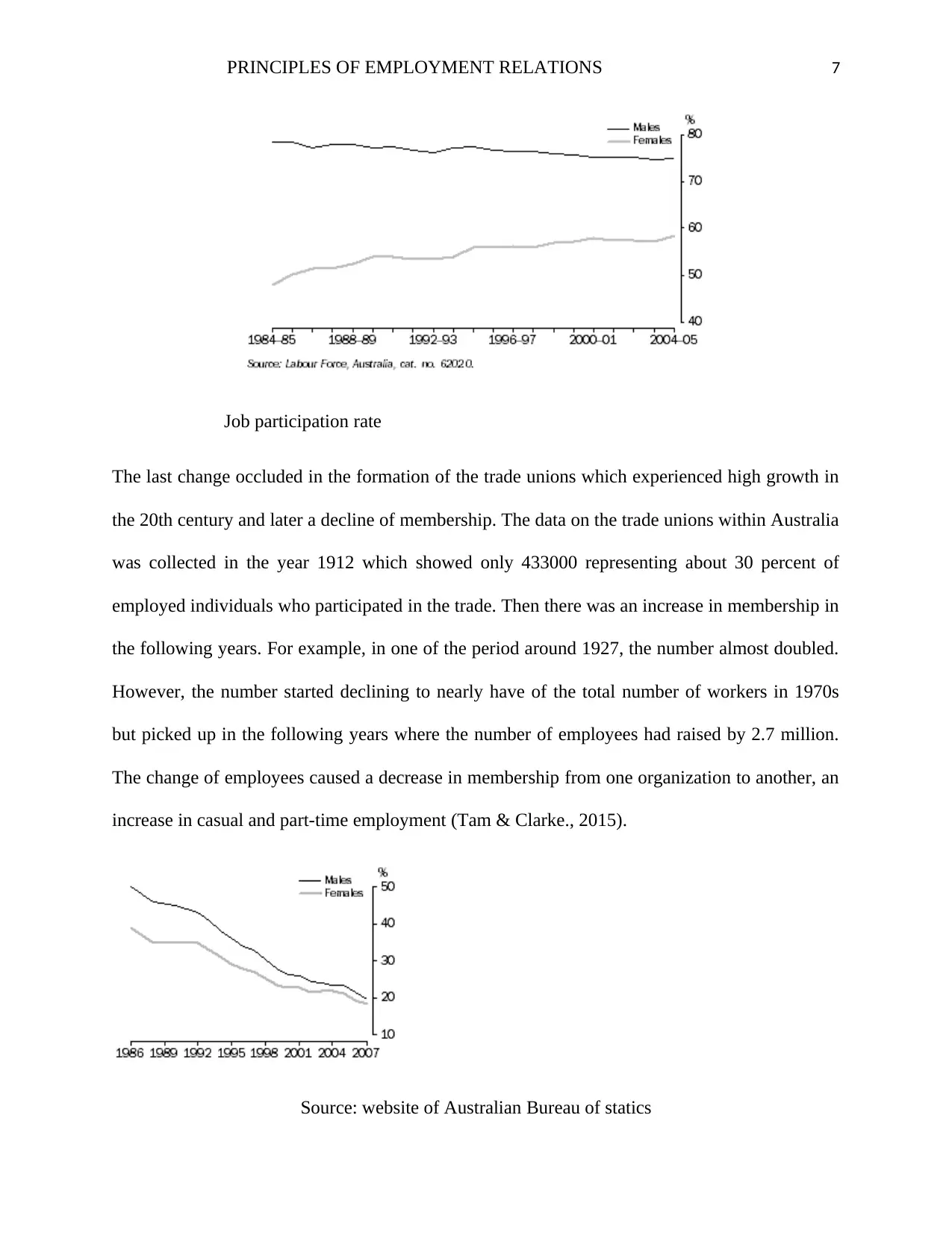
PRINCIPLES OF EMPLOYMENT RELATIONS 7
Job participation rate
The last change occluded in the formation of the trade unions which experienced high growth in
the 20th century and later a decline of membership. The data on the trade unions within Australia
was collected in the year 1912 which showed only 433000 representing about 30 percent of
employed individuals who participated in the trade. Then there was an increase in membership in
the following years. For example, in one of the period around 1927, the number almost doubled.
However, the number started declining to nearly have of the total number of workers in 1970s
but picked up in the following years where the number of employees had raised by 2.7 million.
The change of employees caused a decrease in membership from one organization to another, an
increase in casual and part-time employment (Tam & Clarke., 2015).
Source: website of Australian Bureau of statics
Job participation rate
The last change occluded in the formation of the trade unions which experienced high growth in
the 20th century and later a decline of membership. The data on the trade unions within Australia
was collected in the year 1912 which showed only 433000 representing about 30 percent of
employed individuals who participated in the trade. Then there was an increase in membership in
the following years. For example, in one of the period around 1927, the number almost doubled.
However, the number started declining to nearly have of the total number of workers in 1970s
but picked up in the following years where the number of employees had raised by 2.7 million.
The change of employees caused a decrease in membership from one organization to another, an
increase in casual and part-time employment (Tam & Clarke., 2015).
Source: website of Australian Bureau of statics
Paraphrase This Document
Need a fresh take? Get an instant paraphrase of this document with our AI Paraphraser
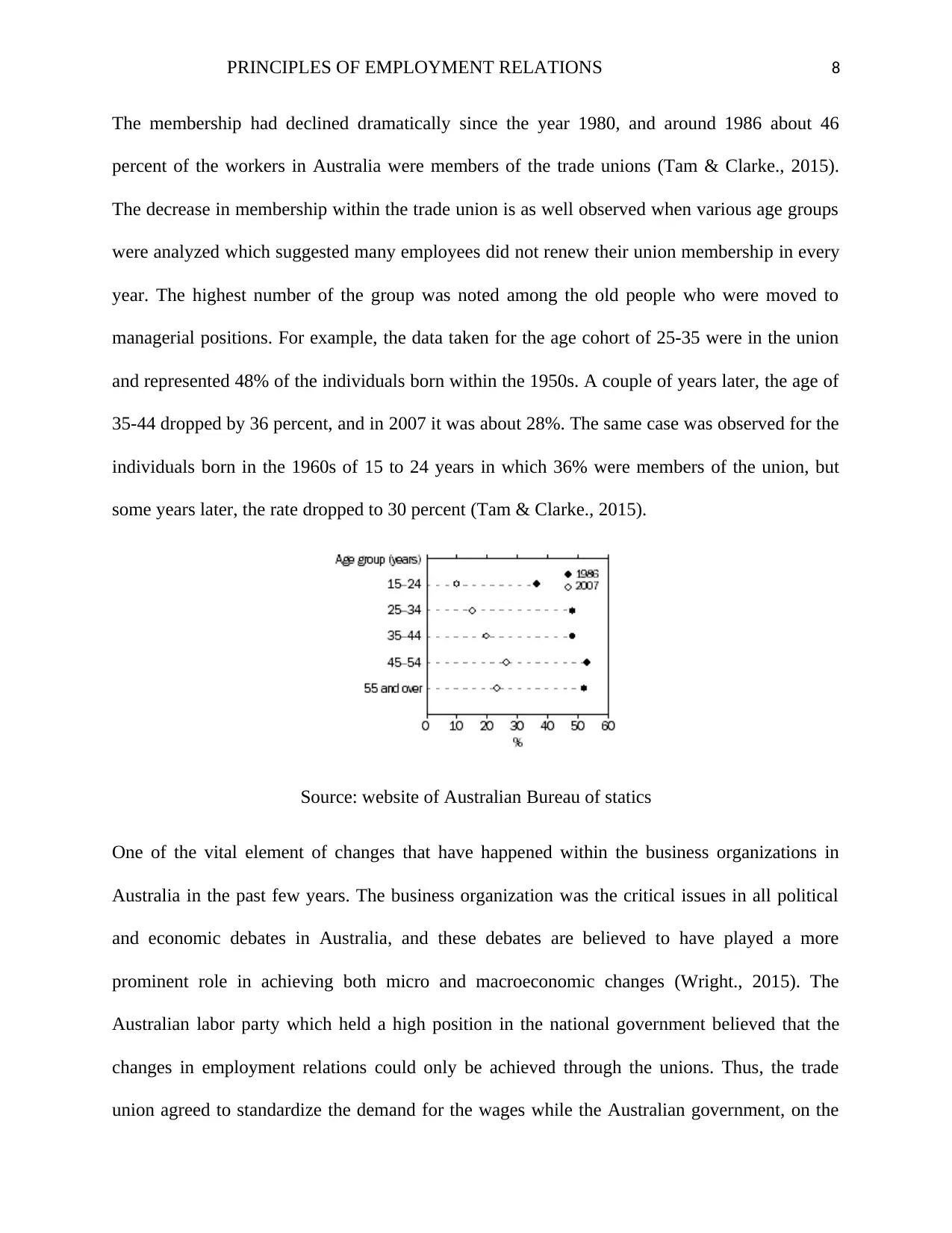
PRINCIPLES OF EMPLOYMENT RELATIONS 8
The membership had declined dramatically since the year 1980, and around 1986 about 46
percent of the workers in Australia were members of the trade unions (Tam & Clarke., 2015).
The decrease in membership within the trade union is as well observed when various age groups
were analyzed which suggested many employees did not renew their union membership in every
year. The highest number of the group was noted among the old people who were moved to
managerial positions. For example, the data taken for the age cohort of 25-35 were in the union
and represented 48% of the individuals born within the 1950s. A couple of years later, the age of
35-44 dropped by 36 percent, and in 2007 it was about 28%. The same case was observed for the
individuals born in the 1960s of 15 to 24 years in which 36% were members of the union, but
some years later, the rate dropped to 30 percent (Tam & Clarke., 2015).
Source: website of Australian Bureau of statics
One of the vital element of changes that have happened within the business organizations in
Australia in the past few years. The business organization was the critical issues in all political
and economic debates in Australia, and these debates are believed to have played a more
prominent role in achieving both micro and macroeconomic changes (Wright., 2015). The
Australian labor party which held a high position in the national government believed that the
changes in employment relations could only be achieved through the unions. Thus, the trade
union agreed to standardize the demand for the wages while the Australian government, on the
The membership had declined dramatically since the year 1980, and around 1986 about 46
percent of the workers in Australia were members of the trade unions (Tam & Clarke., 2015).
The decrease in membership within the trade union is as well observed when various age groups
were analyzed which suggested many employees did not renew their union membership in every
year. The highest number of the group was noted among the old people who were moved to
managerial positions. For example, the data taken for the age cohort of 25-35 were in the union
and represented 48% of the individuals born within the 1950s. A couple of years later, the age of
35-44 dropped by 36 percent, and in 2007 it was about 28%. The same case was observed for the
individuals born in the 1960s of 15 to 24 years in which 36% were members of the union, but
some years later, the rate dropped to 30 percent (Tam & Clarke., 2015).
Source: website of Australian Bureau of statics
One of the vital element of changes that have happened within the business organizations in
Australia in the past few years. The business organization was the critical issues in all political
and economic debates in Australia, and these debates are believed to have played a more
prominent role in achieving both micro and macroeconomic changes (Wright., 2015). The
Australian labor party which held a high position in the national government believed that the
changes in employment relations could only be achieved through the unions. Thus, the trade
union agreed to standardize the demand for the wages while the Australian government, on the
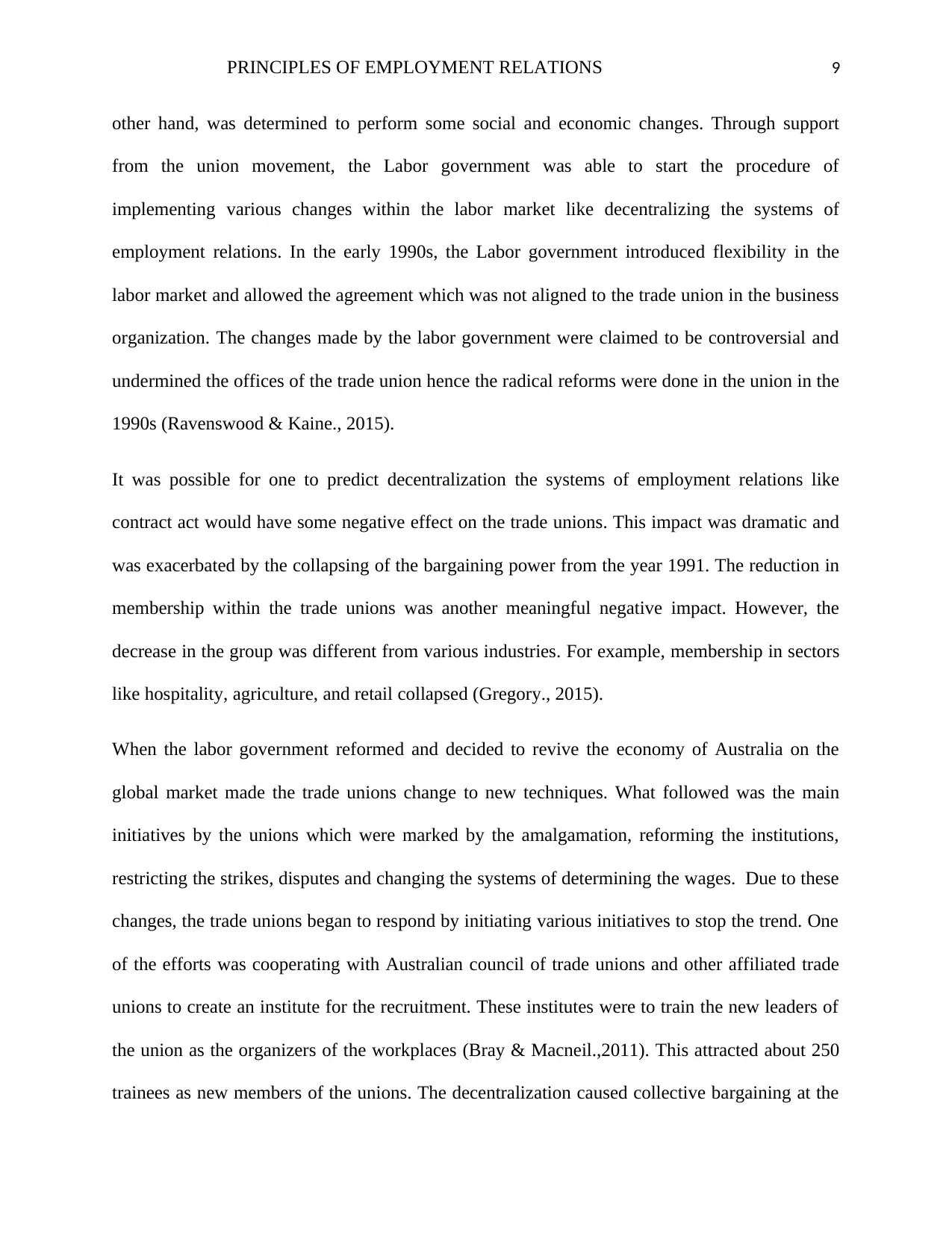
PRINCIPLES OF EMPLOYMENT RELATIONS 9
other hand, was determined to perform some social and economic changes. Through support
from the union movement, the Labor government was able to start the procedure of
implementing various changes within the labor market like decentralizing the systems of
employment relations. In the early 1990s, the Labor government introduced flexibility in the
labor market and allowed the agreement which was not aligned to the trade union in the business
organization. The changes made by the labor government were claimed to be controversial and
undermined the offices of the trade union hence the radical reforms were done in the union in the
1990s (Ravenswood & Kaine., 2015).
It was possible for one to predict decentralization the systems of employment relations like
contract act would have some negative effect on the trade unions. This impact was dramatic and
was exacerbated by the collapsing of the bargaining power from the year 1991. The reduction in
membership within the trade unions was another meaningful negative impact. However, the
decrease in the group was different from various industries. For example, membership in sectors
like hospitality, agriculture, and retail collapsed (Gregory., 2015).
When the labor government reformed and decided to revive the economy of Australia on the
global market made the trade unions change to new techniques. What followed was the main
initiatives by the unions which were marked by the amalgamation, reforming the institutions,
restricting the strikes, disputes and changing the systems of determining the wages. Due to these
changes, the trade unions began to respond by initiating various initiatives to stop the trend. One
of the efforts was cooperating with Australian council of trade unions and other affiliated trade
unions to create an institute for the recruitment. These institutes were to train the new leaders of
the union as the organizers of the workplaces (Bray & Macneil.,2011). This attracted about 250
trainees as new members of the unions. The decentralization caused collective bargaining at the
other hand, was determined to perform some social and economic changes. Through support
from the union movement, the Labor government was able to start the procedure of
implementing various changes within the labor market like decentralizing the systems of
employment relations. In the early 1990s, the Labor government introduced flexibility in the
labor market and allowed the agreement which was not aligned to the trade union in the business
organization. The changes made by the labor government were claimed to be controversial and
undermined the offices of the trade union hence the radical reforms were done in the union in the
1990s (Ravenswood & Kaine., 2015).
It was possible for one to predict decentralization the systems of employment relations like
contract act would have some negative effect on the trade unions. This impact was dramatic and
was exacerbated by the collapsing of the bargaining power from the year 1991. The reduction in
membership within the trade unions was another meaningful negative impact. However, the
decrease in the group was different from various industries. For example, membership in sectors
like hospitality, agriculture, and retail collapsed (Gregory., 2015).
When the labor government reformed and decided to revive the economy of Australia on the
global market made the trade unions change to new techniques. What followed was the main
initiatives by the unions which were marked by the amalgamation, reforming the institutions,
restricting the strikes, disputes and changing the systems of determining the wages. Due to these
changes, the trade unions began to respond by initiating various initiatives to stop the trend. One
of the efforts was cooperating with Australian council of trade unions and other affiliated trade
unions to create an institute for the recruitment. These institutes were to train the new leaders of
the union as the organizers of the workplaces (Bray & Macneil.,2011). This attracted about 250
trainees as new members of the unions. The decentralization caused collective bargaining at the
⊘ This is a preview!⊘
Do you want full access?
Subscribe today to unlock all pages.

Trusted by 1+ million students worldwide
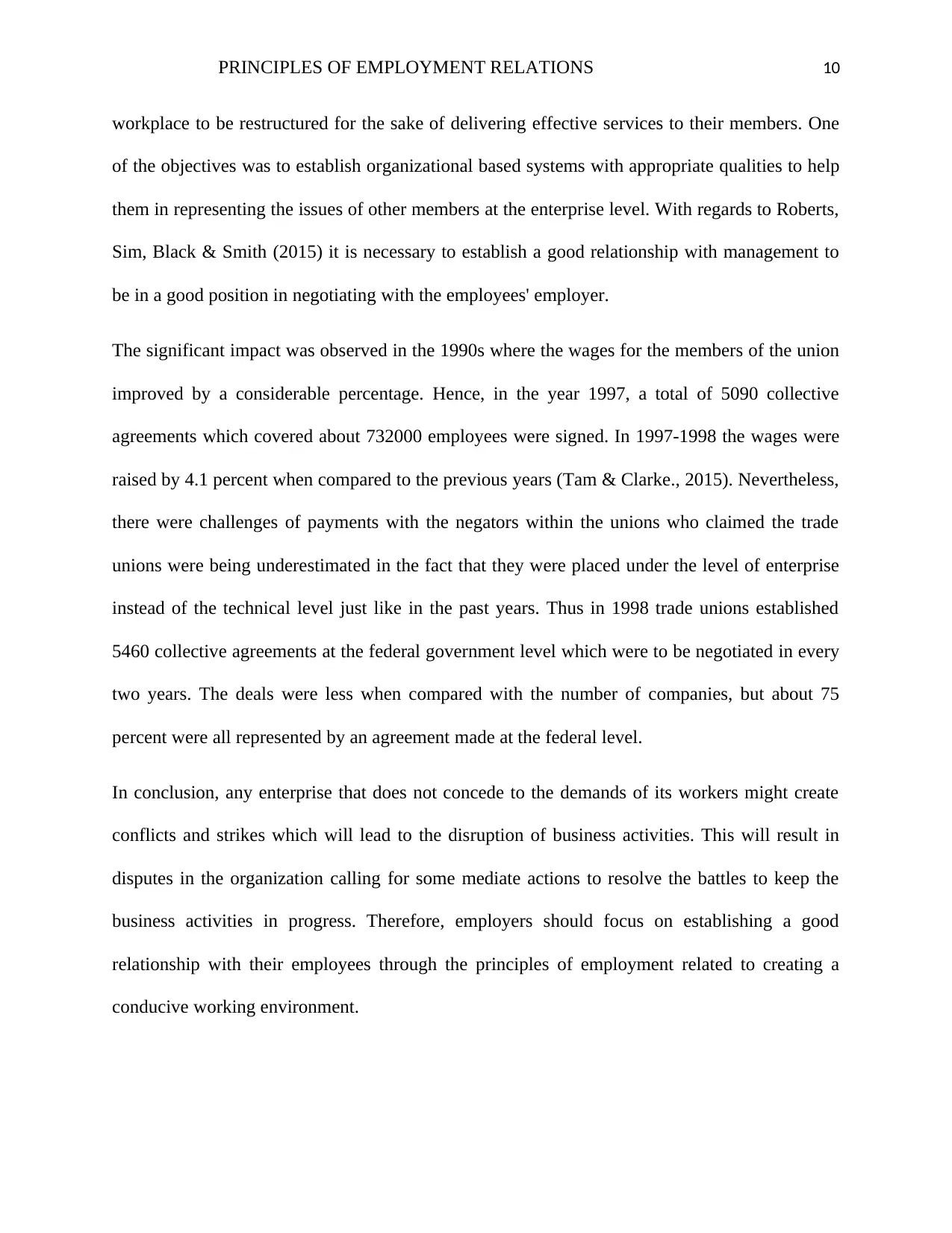
PRINCIPLES OF EMPLOYMENT RELATIONS 10
workplace to be restructured for the sake of delivering effective services to their members. One
of the objectives was to establish organizational based systems with appropriate qualities to help
them in representing the issues of other members at the enterprise level. With regards to Roberts,
Sim, Black & Smith (2015) it is necessary to establish a good relationship with management to
be in a good position in negotiating with the employees' employer.
The significant impact was observed in the 1990s where the wages for the members of the union
improved by a considerable percentage. Hence, in the year 1997, a total of 5090 collective
agreements which covered about 732000 employees were signed. In 1997-1998 the wages were
raised by 4.1 percent when compared to the previous years (Tam & Clarke., 2015). Nevertheless,
there were challenges of payments with the negators within the unions who claimed the trade
unions were being underestimated in the fact that they were placed under the level of enterprise
instead of the technical level just like in the past years. Thus in 1998 trade unions established
5460 collective agreements at the federal government level which were to be negotiated in every
two years. The deals were less when compared with the number of companies, but about 75
percent were all represented by an agreement made at the federal level.
In conclusion, any enterprise that does not concede to the demands of its workers might create
conflicts and strikes which will lead to the disruption of business activities. This will result in
disputes in the organization calling for some mediate actions to resolve the battles to keep the
business activities in progress. Therefore, employers should focus on establishing a good
relationship with their employees through the principles of employment related to creating a
conducive working environment.
workplace to be restructured for the sake of delivering effective services to their members. One
of the objectives was to establish organizational based systems with appropriate qualities to help
them in representing the issues of other members at the enterprise level. With regards to Roberts,
Sim, Black & Smith (2015) it is necessary to establish a good relationship with management to
be in a good position in negotiating with the employees' employer.
The significant impact was observed in the 1990s where the wages for the members of the union
improved by a considerable percentage. Hence, in the year 1997, a total of 5090 collective
agreements which covered about 732000 employees were signed. In 1997-1998 the wages were
raised by 4.1 percent when compared to the previous years (Tam & Clarke., 2015). Nevertheless,
there were challenges of payments with the negators within the unions who claimed the trade
unions were being underestimated in the fact that they were placed under the level of enterprise
instead of the technical level just like in the past years. Thus in 1998 trade unions established
5460 collective agreements at the federal government level which were to be negotiated in every
two years. The deals were less when compared with the number of companies, but about 75
percent were all represented by an agreement made at the federal level.
In conclusion, any enterprise that does not concede to the demands of its workers might create
conflicts and strikes which will lead to the disruption of business activities. This will result in
disputes in the organization calling for some mediate actions to resolve the battles to keep the
business activities in progress. Therefore, employers should focus on establishing a good
relationship with their employees through the principles of employment related to creating a
conducive working environment.
Paraphrase This Document
Need a fresh take? Get an instant paraphrase of this document with our AI Paraphraser
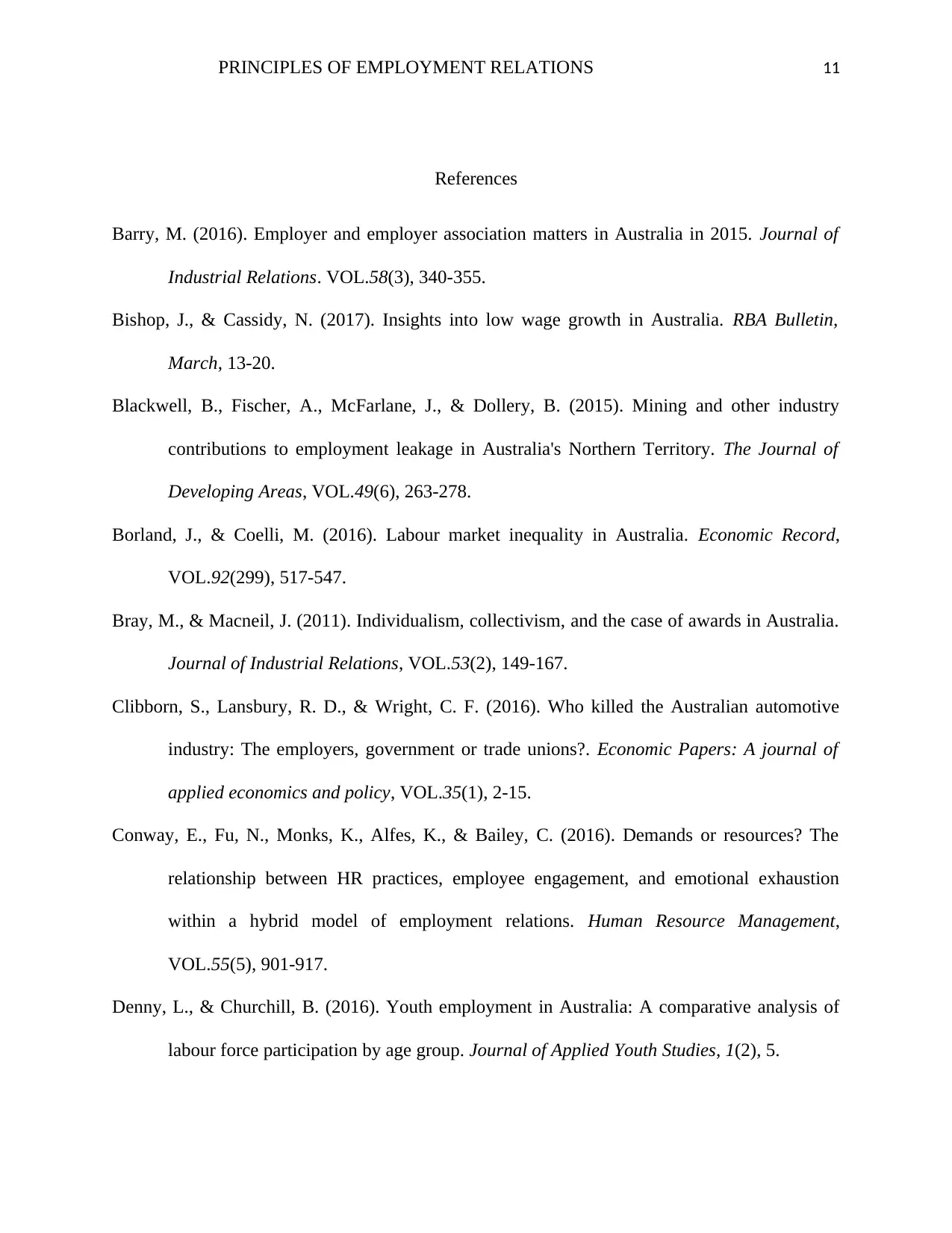
PRINCIPLES OF EMPLOYMENT RELATIONS 11
References
Barry, M. (2016). Employer and employer association matters in Australia in 2015. Journal of
Industrial Relations. VOL.58(3), 340-355.
Bishop, J., & Cassidy, N. (2017). Insights into low wage growth in Australia. RBA Bulletin,
March, 13-20.
Blackwell, B., Fischer, A., McFarlane, J., & Dollery, B. (2015). Mining and other industry
contributions to employment leakage in Australia's Northern Territory. The Journal of
Developing Areas, VOL.49(6), 263-278.
Borland, J., & Coelli, M. (2016). Labour market inequality in Australia. Economic Record,
VOL.92(299), 517-547.
Bray, M., & Macneil, J. (2011). Individualism, collectivism, and the case of awards in Australia.
Journal of Industrial Relations, VOL.53(2), 149-167.
Clibborn, S., Lansbury, R. D., & Wright, C. F. (2016). Who killed the Australian automotive
industry: The employers, government or trade unions?. Economic Papers: A journal of
applied economics and policy, VOL.35(1), 2-15.
Conway, E., Fu, N., Monks, K., Alfes, K., & Bailey, C. (2016). Demands or resources? The
relationship between HR practices, employee engagement, and emotional exhaustion
within a hybrid model of employment relations. Human Resource Management,
VOL.55(5), 901-917.
Denny, L., & Churchill, B. (2016). Youth employment in Australia: A comparative analysis of
labour force participation by age group. Journal of Applied Youth Studies, 1(2), 5.
References
Barry, M. (2016). Employer and employer association matters in Australia in 2015. Journal of
Industrial Relations. VOL.58(3), 340-355.
Bishop, J., & Cassidy, N. (2017). Insights into low wage growth in Australia. RBA Bulletin,
March, 13-20.
Blackwell, B., Fischer, A., McFarlane, J., & Dollery, B. (2015). Mining and other industry
contributions to employment leakage in Australia's Northern Territory. The Journal of
Developing Areas, VOL.49(6), 263-278.
Borland, J., & Coelli, M. (2016). Labour market inequality in Australia. Economic Record,
VOL.92(299), 517-547.
Bray, M., & Macneil, J. (2011). Individualism, collectivism, and the case of awards in Australia.
Journal of Industrial Relations, VOL.53(2), 149-167.
Clibborn, S., Lansbury, R. D., & Wright, C. F. (2016). Who killed the Australian automotive
industry: The employers, government or trade unions?. Economic Papers: A journal of
applied economics and policy, VOL.35(1), 2-15.
Conway, E., Fu, N., Monks, K., Alfes, K., & Bailey, C. (2016). Demands or resources? The
relationship between HR practices, employee engagement, and emotional exhaustion
within a hybrid model of employment relations. Human Resource Management,
VOL.55(5), 901-917.
Denny, L., & Churchill, B. (2016). Youth employment in Australia: A comparative analysis of
labour force participation by age group. Journal of Applied Youth Studies, 1(2), 5.
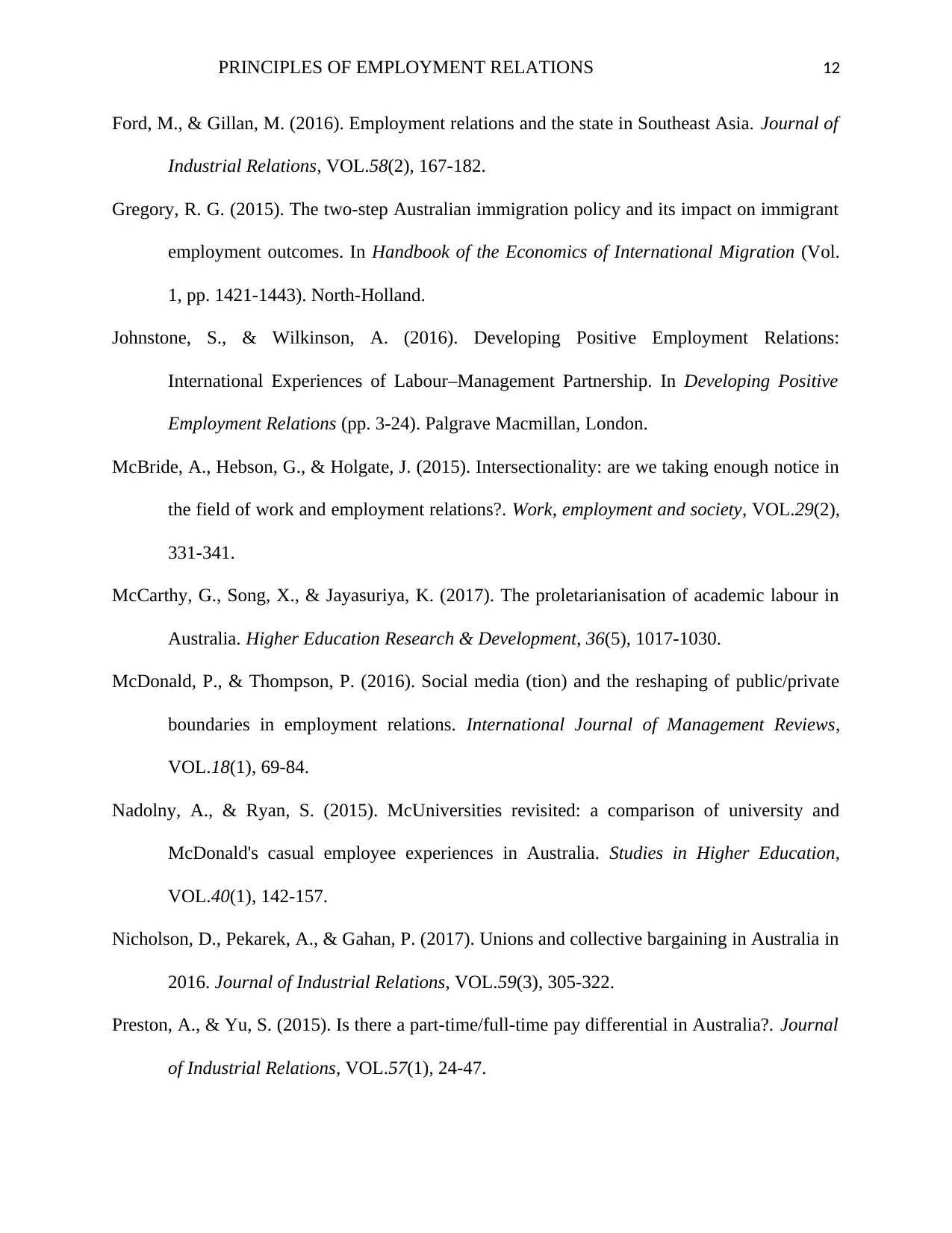
PRINCIPLES OF EMPLOYMENT RELATIONS 12
Ford, M., & Gillan, M. (2016). Employment relations and the state in Southeast Asia. Journal of
Industrial Relations, VOL.58(2), 167-182.
Gregory, R. G. (2015). The two-step Australian immigration policy and its impact on immigrant
employment outcomes. In Handbook of the Economics of International Migration (Vol.
1, pp. 1421-1443). North-Holland.
Johnstone, S., & Wilkinson, A. (2016). Developing Positive Employment Relations:
International Experiences of Labour–Management Partnership. In Developing Positive
Employment Relations (pp. 3-24). Palgrave Macmillan, London.
McBride, A., Hebson, G., & Holgate, J. (2015). Intersectionality: are we taking enough notice in
the field of work and employment relations?. Work, employment and society, VOL.29(2),
331-341.
McCarthy, G., Song, X., & Jayasuriya, K. (2017). The proletarianisation of academic labour in
Australia. Higher Education Research & Development, 36(5), 1017-1030.
McDonald, P., & Thompson, P. (2016). Social media (tion) and the reshaping of public/private
boundaries in employment relations. International Journal of Management Reviews,
VOL.18(1), 69-84.
Nadolny, A., & Ryan, S. (2015). McUniversities revisited: a comparison of university and
McDonald's casual employee experiences in Australia. Studies in Higher Education,
VOL.40(1), 142-157.
Nicholson, D., Pekarek, A., & Gahan, P. (2017). Unions and collective bargaining in Australia in
2016. Journal of Industrial Relations, VOL.59(3), 305-322.
Preston, A., & Yu, S. (2015). Is there a part-time/full-time pay differential in Australia?. Journal
of Industrial Relations, VOL.57(1), 24-47.
Ford, M., & Gillan, M. (2016). Employment relations and the state in Southeast Asia. Journal of
Industrial Relations, VOL.58(2), 167-182.
Gregory, R. G. (2015). The two-step Australian immigration policy and its impact on immigrant
employment outcomes. In Handbook of the Economics of International Migration (Vol.
1, pp. 1421-1443). North-Holland.
Johnstone, S., & Wilkinson, A. (2016). Developing Positive Employment Relations:
International Experiences of Labour–Management Partnership. In Developing Positive
Employment Relations (pp. 3-24). Palgrave Macmillan, London.
McBride, A., Hebson, G., & Holgate, J. (2015). Intersectionality: are we taking enough notice in
the field of work and employment relations?. Work, employment and society, VOL.29(2),
331-341.
McCarthy, G., Song, X., & Jayasuriya, K. (2017). The proletarianisation of academic labour in
Australia. Higher Education Research & Development, 36(5), 1017-1030.
McDonald, P., & Thompson, P. (2016). Social media (tion) and the reshaping of public/private
boundaries in employment relations. International Journal of Management Reviews,
VOL.18(1), 69-84.
Nadolny, A., & Ryan, S. (2015). McUniversities revisited: a comparison of university and
McDonald's casual employee experiences in Australia. Studies in Higher Education,
VOL.40(1), 142-157.
Nicholson, D., Pekarek, A., & Gahan, P. (2017). Unions and collective bargaining in Australia in
2016. Journal of Industrial Relations, VOL.59(3), 305-322.
Preston, A., & Yu, S. (2015). Is there a part-time/full-time pay differential in Australia?. Journal
of Industrial Relations, VOL.57(1), 24-47.
⊘ This is a preview!⊘
Do you want full access?
Subscribe today to unlock all pages.

Trusted by 1+ million students worldwide
1 out of 13
Related Documents
Your All-in-One AI-Powered Toolkit for Academic Success.
+13062052269
info@desklib.com
Available 24*7 on WhatsApp / Email
![[object Object]](/_next/static/media/star-bottom.7253800d.svg)
Unlock your academic potential
Copyright © 2020–2025 A2Z Services. All Rights Reserved. Developed and managed by ZUCOL.





